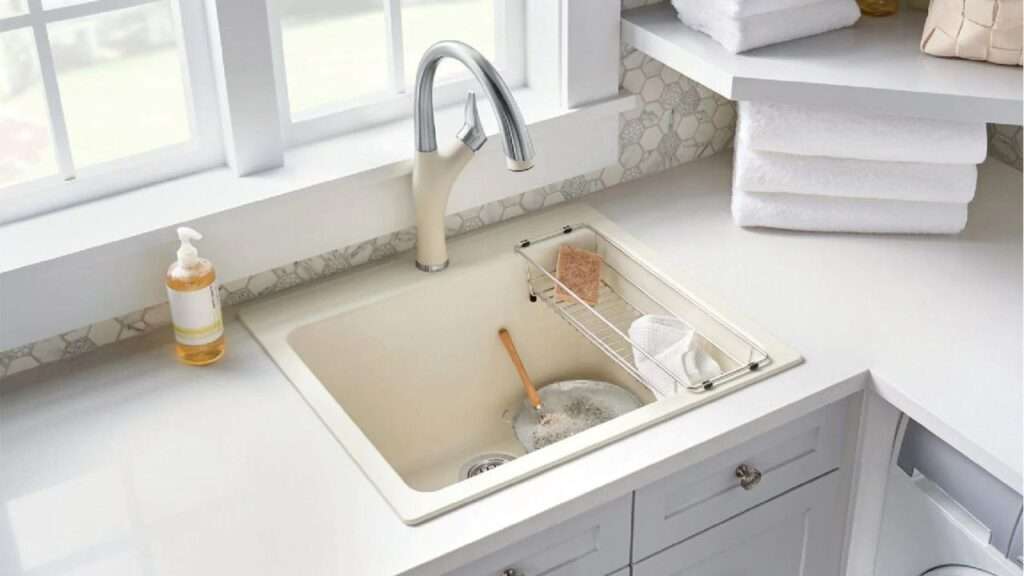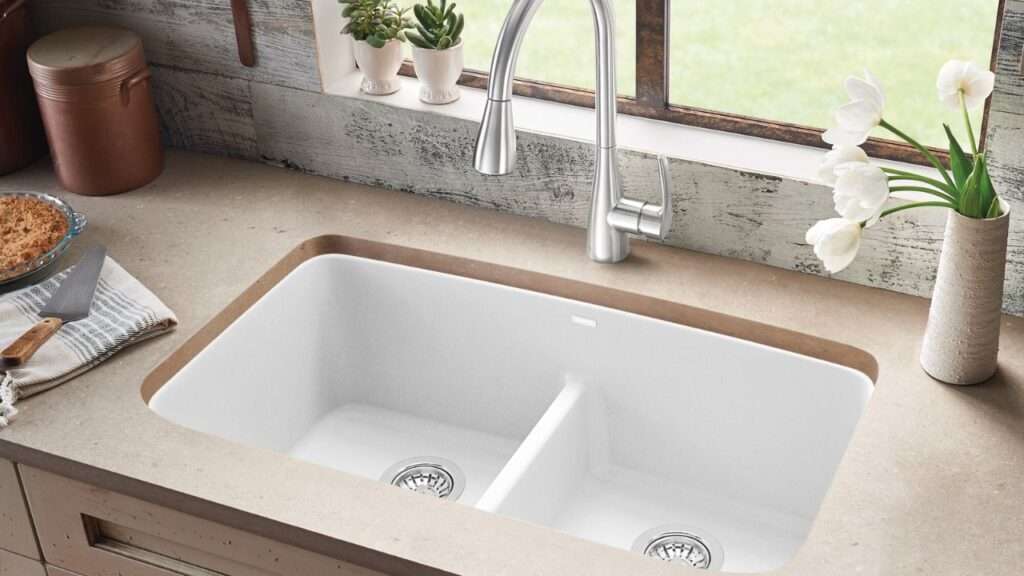If you are planning to renovate your kitchen or build a new one? One important factor you should consider is the kitchen sink size. The size of your kitchen sink plays a crucial role in the overall functionality and aesthetics of your kitchen.
In this article, we will guide you through the process of choosing the perfect standard kitchen sink size for your home. From understanding the importance of size to reviews for different kitchen layouts, we’ll cover everything you need to know. So let’s dive in!
Optimize Your Kitchen with the Perfect Size Sink for Efficiency
The kitchen sink is an essential part of any kitchen. It serves as a workspace for meal preparation, a cleaning station for dishes, and a focal point for kitchen design. The size of your kitchen sink determines its functionality and how well it fits into your kitchen space.

Choosing the right size is crucial to ensure a seamless workflow and enhance the overall aesthetics of your kitchen.
Understanding Standard Kitchen Sink Dimensions
When it comes to kitchen sinks, standard dimensions are available to help homeowners make informed decisions. Here are a few key considerations regarding sink dimensions:
Single Bowl vs. Double Bowl Sinks
Single bowl sinks consist of one large basin, offering ample space for washing large pots and pans. On the other hand, double bowl sinks provide two separate basins, allowing you to multitask efficiently. The choice between single and double bowl sinks depends on your personal preferences and kitchen requirements.
Depth and Width Reviews
The depth and width of the sink are crucial factors to consider. Deeper sinks can accommodate larger items and minimize splashing, while shallower sinks are more convenient for shorter individuals or individuals with physical limitations.
The width of the sink should align with the available countertop space and cabinet dimensions.
Optimal Sink Sizes for Different Kitchen Layouts: A Comprehensive Guide
Choosing the right sink size is crucial when considering different kitchen layouts. In smaller kitchens, a compact sink is more suitable to maximize countertop space. However, in larger kitchens, you have the flexibility to opt for larger sinks that can accommodate your needs.

This comprehensive guide provides valuable insights into selecting optimal sink sizes based on various kitchen layouts. Whether you have an open-concept kitchen, a galley kitchen, or an L-shaped or U-shaped kitchen, understanding the appropriate sink size helps optimize workflow and enhances functionality.
By considering the specific requirements of different kitchen layouts, you can make informed decisions and create a well-designed kitchen space that meets your needs.
Accurate Kitchen Measurements: Key to Choosing the Right Sink Size
Before choosing a kitchen sink size, measuring your kitchen space accurately is essential. Consider the following measurements:
Sink Base Cabinet Size
The sink base cabinet determines the maximum size of the sink you can install. Measure the interior dimensions of the sink base cabinet to ensure the sink fits appropriately and doesn’t interfere with other elements, such as plumbing.
Countertop Dimensions
Take precise measurements of your countertop to determine the available space for the sink. Consider any existing cutouts or limitations that may affect the size and placement of the sink.
Determining the Right Kitchen Sink Size for Your Needs
Choosing the right sink size goes beyond just the physical dimensions. Consider the following factors to determine the optimal size for your needs:
Family Size and Lifestyle
The size of your family and your daily kitchen activities play a significant role in selecting the sink size. Larger families may benefit from bigger sinks to handle larger loads of dishes, while smaller families or individuals may opt for more compact sizes.
Cooking and Cleaning Habits
If you enjoy cooking elaborate meals or frequently entertain guests, a larger sink can accommodate the increased volume of dishes and cookware. Likewise, if you prefer minimalistic cooking and have a dishwasher, a smaller sink may be sufficient.
Frequency of Dishwashing
Consider how often you wash dishes by hand. If you rely heavily on your dishwasher, a smaller sink may suffice. However, if you prefer handwashing or have limited access to a dishwasher, a larger sink can make the task more manageable.
Finding the Perfect Sink Size: Functionality Meets Aesthetics
Choosing the perfect sink size involves finding a balance between functionality and aesthetics. Here are a couple of considerations to keep in mind:
Sink Proportions and Kitchen Design
Ensure the proportions of the sink align with your kitchen design. A large sink in a small kitchen can overwhelm the space, while a small sink in a spacious kitchen may appear disproportionate.
Matching Sink Size with Faucet and Accessories
Consider the size and style of your faucet and other accessories, such as soap dispensers and sprayers. They should complement the sink size and ensure smooth operation.
Installation Tips and Reviews For kitchen sink
Installing a kitchen sink requires careful planning. Consider the following tips and reviews:
Undermount vs. Drop-In Sinks
Choose between undermount and drop-in sinks based on your preferences and countertop material. Undermount sinks provide a seamless look with easy countertop cleanup, while drop-in sinks are more straightforward to install and replace.
Plumbing and Drainage Requirements
Ensure your chosen sink size aligns with the plumbing and drainage system in your kitchen. Consult a professional if you have any doubts or need assistance with modifications.
Maintenance and Cleaning Tips for kitchen sink
Proper maintenance and cleaning can prolong the lifespan of your kitchen sink. Here are a few tips to keep in mind:
Cleaning and Care Tips
Follow the manufacturer’s guidelines for cleaning and maintaining your specific sink material. Use appropriate cleaning agents and avoid abrasive tools or chemicals that can damage the surface.
Avoiding Common Sink Size Mistakes
Avoid common mistakes such as choosing a sink that is too small for your needs or installing a sink that doesn’t align with your kitchen layout. Proper planning and consideration can help you avoid these pitfalls.
Standard Kitchen Sink Size For the United States
The standard kitchen sink size in the United States typically ranges from 22 to 36 inches in length, 19 to 24 inches in width, and 8 to 10 inches in depth. These dimensions are commonly found in most residential kitchens and provide a balance between functionality and space utilization.

However, it’s important to note that sink sizes can vary depending on individual preferences and specific kitchen requirements. Considering the available space and personal needs will help determine the ideal standard kitchen sink size for your United States home.
Conclusion
Choosing the perfect standard kitchen sink size for your home involves a thoughtful evaluation of your needs, kitchen space, and personal preferences. By considering factors such as family size, lifestyle, and kitchen layout, you can select a sink that enhances both functionality and aesthetics in your kitchen.
Remember to measure your space accurately and consult professionals if needed for a seamless installation process.
Frequently Asked Questions
Q. What is the standard size for a kitchen sink?
The standard size for a kitchen sink can vary, but a typical dimension for a single bowl sink is 22 inches in length and 30 inches in width.
Q. Should I choose a single bowl or double bowl sink?
The choice between a single-bowl or double-bowl sink depends on your personal preferences and kitchen requirements. Single-bowl sinks offer more space for larger items, while double-bowl sinks allow for multitasking.
Q. How do I measure my kitchen space for a sink?
Measure the dimensions of your sink base cabinet and countertop to ensure a proper fit. Consider any existing cutouts or limitations that may affect the size and placement of the sink.
Q. Can I install a larger sink in a small kitchen?
While it’s possible to install a larger sink in a small kitchen, it may overwhelm the space. Consider the proportions and balance with the overall kitchen design.
Q. What maintenance tips should I follow for my kitchen sink?
Follow the manufacturer’s guidelines for cleaning and maintenance. Use appropriate cleaning agents and avoid abrasive tools or chemicals that can damage the sink surface.
Follow the manufacturer’s guidelines for cleaning and maintenance. Use appropriate cleaning agents and avoid abrasive tools or chemicals that can damage the sink surface.
Read More:15 Stunning Porch Ceiling Ideas That Will Take Your Outdoor Space to the Next Level